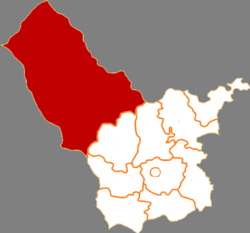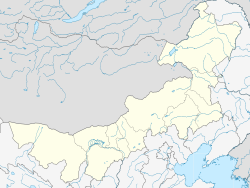Dorbod Banner
Dorbod Banner
Tứ tử vương kỳ·ᠳᠥᠷᠪᠡᠳ ᠬᠣᠰᠢᠭᠤ Siziwang | |
|---|---|
 | |
 Dorbod in Ulanqab | |
 Ulanqab in Inner Mongolia | |
| Coordinates:41°31′59″N111°42′24″E/ 41.53306°N 111.70667°E | |
| Country | China |
| Autonomous region | Inner Mongolia |
| Prefecture-level city | Ulanqab |
| Banner seat | Ulan Hua |
| Area | |
| • Total | 25,513 km2(9,851 sq mi) |
| Population (2020)[1] | |
| • Total | 129,372 |
| • Density | 5.1/km2(13/sq mi) |
| Time zone | UTC+8(China Standard) |
| Website | www |
| Dorbod Banner | |||||||
|---|---|---|---|---|---|---|---|
| Chinese name | |||||||
| Chinese | Tứ tử vương kỳ | ||||||
| |||||||
| Mongolian name | |||||||
| Mongolian Cyrillic | Дөрвөд хошуу | ||||||
| Mongolian script | ᠳᠥᠷᠪᠡᠳ ᠬᠣᠰᠢᠭᠤ | ||||||
| |||||||
Dorbod BannerorSiziwang Banner(Mongolian:ᠳᠥᠷᠪᠡᠳ ᠬᠣᠰᠢᠭᠤ;Chinese:Tứ tử vương kỳ) is abanner(countyequivalent) inUlanqab,Inner Mongolia,China,[2]borderingMongolia'sDornogovi Provinceto the northwest. It is located about 80 km (50 mi) north ofHohhot,the capital of Inner Mongolia.
The banner spans 25,513 square kilometres (9,851 sq mi), and has a population of 129,372 as of 2020.[3]Its seat of government is located inWulanhua.[4]
Toponymy[edit]
The Chinese name for the bannersiziwang,literally "four princes", derives from the area's historic rule by four brothers.[3]The Mongolian name for the bannerdorbedmeans "of four".[citation needed]
History[edit]

The area of Dorbod Banner was ruled by four Mongol brothers, Sengge (Сэнгэ,Chinese:Tăng cách), Suonuobu (Chinese:Tác nặc bố), Bonpo (Бумба,Chinese:Ngạc mộc bố) and Yi'erzhamu (Chinese:Y nhĩ trát mộc), who were descendants ofHasar,a brother ofGenghis Khan.[citation needed]They led their tribe in participating in theManchuQing Dynasty's conquest ofMingChina in the early 17th century.[citation needed]In recognition of their service, the Qing court made Emubu the Duoluo Commandery Prince (Chinese:Đa la quận vương) in 1649 and settled their tribe in the area of modern Siziwang Banner.[citation needed]The title was hereditary and passed through fourteen of his descendants before theChinese Communist Partyabolished all hereditary titles in Inner Mongolia in 1949.[citation needed]The last prince, Sudanamuchaogeji (Chinese:Tô đạt na mộc triều cách cát), died as a private citizen in 1957.[citation needed]There is a sculpture of the four original princes in Wulanhua, erected in 2003.[1]
Geography[edit]
To its east liesSonid Right Banner,Qahar Right Rear Banner,andQahar Right Middle Banner.[4]To its south liesWuchuan CountyandZhuozi County.[4]To its west liesDarhan Muminggan United Banner.[4]Its north is formed by a 104 kilometres (65 mi) border withMongolia.[4]
Its seat of government, thetownofWulanhua,is located 105 kilometres (65 mi) away fromHohhot,and 270 kilometres (170 mi) away fromErlianhot.[4]
The banner is located along the northern foothills of theYin Mountains,and has an average elevation of 1,400 metres (4,600 ft).[4]Most of the banner's area is grassland.[4]
Climate[edit]
The banner experiences an average of 250 millimetres (9.8 in) to 300 millimetres (12 in) of precipitation annually.[4]Its average annual temperature is 3 °C (37 °F).[4]
| Climate data for Dorbod Banner, elevation 1,445 m (4,741 ft), (1991–2020 normals, extremes 1981–2010) | |||||||||||||
|---|---|---|---|---|---|---|---|---|---|---|---|---|---|
| Month | Jan | Feb | Mar | Apr | May | Jun | Jul | Aug | Sep | Oct | Nov | Dec | Year |
| Record high °C (°F) | 8.8 (47.8) |
14.9 (58.8) |
20.9 (69.6) |
28.7 (83.7) |
32.3 (90.1) |
36.5 (97.7) |
36.9 (98.4) |
33.5 (92.3) |
32.2 (90.0) |
24.3 (75.7) |
17.9 (64.2) |
12.4 (54.3) |
36.9 (98.4) |
| Mean daily maximum °C (°F) | −6.7 (19.9) |
−2.3 (27.9) |
4.9 (40.8) |
13.5 (56.3) |
20.0 (68.0) |
24.8 (76.6) |
26.9 (80.4) |
24.9 (76.8) |
19.7 (67.5) |
12.0 (53.6) |
2.6 (36.7) |
−5.0 (23.0) |
11.3 (52.3) |
| Daily mean °C (°F) | −14.3 (6.3) |
−9.9 (14.2) |
−2.2 (28.0) |
6.3 (43.3) |
13.2 (55.8) |
18.3 (64.9) |
20.7 (69.3) |
18.5 (65.3) |
12.8 (55.0) |
5.0 (41.0) |
−4.2 (24.4) |
−11.8 (10.8) |
4.4 (39.9) |
| Mean daily minimum °C (°F) | −19.9 (−3.8) |
−15.7 (3.7) |
−8.2 (17.2) |
−0.4 (31.3) |
6.2 (43.2) |
11.7 (53.1) |
14.7 (58.5) |
12.6 (54.7) |
7.0 (44.6) |
−0.4 (31.3) |
−9.1 (15.6) |
−16.9 (1.6) |
−1.5 (29.3) |
| Record low °C (°F) | −34.2 (−29.6) |
−30.8 (−23.4) |
−27.7 (−17.9) |
−15.0 (5.0) |
−7.4 (18.7) |
0.5 (32.9) |
6.4 (43.5) |
1.9 (35.4) |
−5.4 (22.3) |
−14.1 (6.6) |
−27.1 (−16.8) |
−32.7 (−26.9) |
−34.2 (−29.6) |
| Averageprecipitationmm (inches) | 3.5 (0.14) |
4.5 (0.18) |
7.9 (0.31) |
13.0 (0.51) |
29.9 (1.18) |
44.5 (1.75) |
81.8 (3.22) |
63.6 (2.50) |
43.7 (1.72) |
18.7 (0.74) |
7.7 (0.30) |
4.3 (0.17) |
323.1 (12.72) |
| Average precipitation days(≥ 0.1 mm) | 5.4 | 4.9 | 5.7 | 5.0 | 6.8 | 11.1 | 11.4 | 11.1 | 9.0 | 5.4 | 5.8 | 6.1 | 87.7 |
| Average snowy days | 8.7 | 7.2 | 7.3 | 3.7 | 1.0 | 0 | 0 | 0 | 0.3 | 3.1 | 7.4 | 9.0 | 47.7 |
| Averagerelative humidity(%) | 59 | 53 | 43 | 35 | 37 | 46 | 57 | 60 | 56 | 52 | 55 | 58 | 51 |
| Mean monthlysunshine hours | 212.9 | 213.6 | 260.0 | 275.4 | 304.1 | 284.7 | 298.9 | 288.0 | 255.4 | 250.6 | 209.1 | 197.9 | 3,050.6 |
| Percentpossible sunshine | 72 | 71 | 70 | 69 | 67 | 63 | 66 | 68 | 69 | 74 | 72 | 70 | 69 |
| Source:China Meteorological Administration[5][6] | |||||||||||||
Administrative divisions[edit]
Dorbod Banner is divided into 5 towns, 3townships,and 5sums.[7]
| Name | Simplified Chinese | Hanyu Pinyin | Mongolian(Hudum Script) | Mongolian (Cyrillic) | Administrative division code |
|---|---|---|---|---|---|
| Towns | |||||
| Ulan Hua Town | Ô lan hoa trấn | Wūlánhuā Zhèn | ᠤᠯᠠᠭᠠᠨᠬᠤᠸᠠ ᠪᠠᠯᠭᠠᠰᠤ | Улаанухаа балгас | 150929100 |
| Jishengtai Town | Cát sinh thái trấn | Jíshēngtài Zhèn | ᠵᠢᠢ ᠱᠧᠩ ᠲᠠᠢ ᠪᠠᠯᠭᠠᠰᠤ | Жий шинтэй балгас | 150929101 |
| Huret Town | Khố luân đồ trấn | Kùlúntú Zhèn | ᠬᠦᠷᠢᠶᠡᠲᠦ ᠪᠠᠯᠭᠠᠰᠤ | Хүрээт балгас | 150929102 |
| Gongjitang Town | Cung tế đường trấn | Gōngjìtáng Zhèn | ᠭᠦᠩ ᠵᠢᠢ ᠲᠠᠩ ᠪᠠᠯᠭᠠᠰᠤ | Хүн жий даан балгас | 150929103 |
| Bayan Qogt Town | Bạch âm triều khắc đồ trấn | Báiyīncháokètú Zhèn | ᠪᠠᠶᠠᠨᠴᠣᠭᠲᠤ ᠪᠠᠯᠭᠠᠰᠤ | Баянцогт балгас | 150929104 |
| Townships | |||||
| Dongbahao Township | Đông bát hào hương | Dōngbāhào Xiāng | ᠳ᠋ᠦᠩ ᠪᠠ ᠬᠣᠤ ᠰᠢᠶᠠᠩ | Дүн ба хоо шиян | 150929204 |
| Hujirt Township | Hốt kê đồ hương | Hūjītú Xiāng | ᠬᠤᠵᠢᠷᠲᠤ ᠰᠢᠶᠠᠩ | Хужирт шиян | 150929205 |
| Daheihe Township | Đại hắc hà hương | Dàhēihé Xiāng | ᠳ᠋ᠠ ᠾᠧᠢ ᠾᠧ ᠰᠢᠶᠠᠩ | Да гей ге шиян | 150929206 |
| Sums | |||||
| Honggor Sum | Hồng cách nhĩ tô mộc | Hónggé'ěr Sūmù | ᠬᠣᠩᠭᠣᠷ ᠰᠤᠮᠤ | Хонгор сум | 150929200 |
| Janggan Sum | Giang ngạn tô mộc | Jiāng'àn Sūmù | ᠵᠠᠩᠭᠠᠨ ᠰᠤᠮᠤ | Зангаа сум | 150929201 |
| Qagan Bulag Sum | Tra càn bổ lực cách tô mộc | Chágànbǔlìgé Sūmù | ᠴᠠᠭᠠᠨᠪᠤᠯᠠᠭ ᠰᠤᠮᠤ | Цагаанбулаг сум | 150929202 |
| Nomgan Sum | Não mộc canh tô mộc | Nǎomùgèng Sūmù | ᠨᠣᠮᠣᠭᠠᠨ ᠰᠤᠮᠤ | Номгон сум | 150929203 |
| Bayan Obo Sum | Ba âm ngao bao tô mộc | Bāyīn'áobāo Sūmù | ᠪᠠᠶᠠᠨᠣ᠋ᠪᠣᠭᠠ ᠰᠤᠮᠤ | Баянөваа сум | 150929207 |
Other: Ulan Pasture ( ô lan mục tràng )
Demographics[edit]
As of 2009, the banner is home to 216,990 people, up from the 180,568 reported in the2000 Census.[3]
The banner's ethnic minorities include 18,902Mongols(8.71% of the total population), 1,086Manchus(0.50%), and 837Hui people(0.39%).[3]
Economy[edit]
Mineral deposits in the banner includegold,copper,nickel,manganese,fluorite,gypsum,coal,andthenardite.[4]
Spacecraft landing site[edit]
The banner served as the landing sites for China'sShenzhou program.[8]
A pasture known as Amugulang, located inHonggor Sum,about 60 km (37 mi) north of Wulanhua, served as the landing site for theShenzhou-6spacecraft.[9]A specially constructed 64.69 km (40.20 mi) road runs from Wulanhua to Honggor to aid the recovery of the Shenzhou spacecraft, and to boost the local economy.[9]This road shortened the journey between the two towns from two hours to just 40 minutes.[9]
Chinese space program recovery teams (with SUV and recovery trucks) track the progress of re-entry near the landing site and arrive shortly after landing.[10]
A small recovery trucks fitted with a crane lifts the capsule and places it on the rear of the truck for transportation back to the space centre.[citation needed]
Since the final landing ofShenzhou 11in Dorbod Banner in 2016, new facilities have been built to hasten the retrieval process for various spacecraft.[citation needed]
In December 2020, theChang'e 5 spacecraftlanded in Dorbod Banner following a successful collection of Moon rocks.[8]
See also[edit]
Notes[edit]
- ^— All of the names presented here are transcribed fromChinese languagesources usingHanyu Pinyininto the Roman alphabet. However, as these names areMongolianand/orManchuin origin, it would be much more accurate to transcribe them directly from those languages. These transcriptions are, however, unavailable as of now.
References[edit]
- ^Inner Mongolia: Prefectures, Cities, Districts and Counties
- ^2020 niên thống kế dụng khu hoa đại mã ( ô lan sát bố thị )(in Chinese).National Bureau of Statistics of China.2020.Archivedfrom the original on 2020-12-17.Retrieved2020-12-17.
- ^abcdTứ tử vương kỳ lịch sử duyên cách.xzqh.org(in Chinese). 2013-04-16.Archivedfrom the original on 2020-12-17.Retrieved2020-12-17.
- ^abcdefghijkTứ tử vương kỳ khái huống địa đồ.xzqh.org(in Chinese). 2013-04-16.Archivedfrom the original on 2020-12-17.Retrieved2020-12-17.
- ^Trung quốc khí tượng sổ cư võng – WeatherBk Data(in Simplified Chinese).China Meteorological Administration.Retrieved10 October2023.
- ^ Trung quốc khí tượng sổ cư võng(in Simplified Chinese).China Meteorological Administration.Retrieved10 October2023.
- ^2022 niên thống kế dụng khu hoa đại mã ( tứ tử vương kỳ )(in Chinese).National Bureau of Statistics of China.2022.
- ^ab"Chinese Capsule Returns to Earth Carrying Moon Rocks".Time.2020-12-16. Archived fromthe originalon 2020-12-17.Retrieved2020-12-17.
- ^abc"People's Daily Online -- Primary landing site ready to greet Chinese taikonauts back home".people.cn.2005-10-15.Archivedfrom the original on 2020-12-18.Retrieved2020-12-18.
- ^Shenzhou 5Archived2011-06-28 at theWayback Machine


